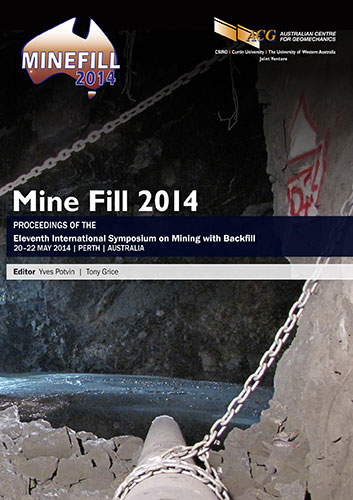Development of a novel technique for geothermal energy extraction from backfilled mine stopes

|
Authors: Ghoreishi-Madiseh, SA; Hassani, FP; Abbasy, F Paper is not available for download Contact Us |
DOI https://doi.org/10.36487/ACG_rep/1404_03_Ghoreishi-Madiseh
Cite As:
Ghoreishi-Madiseh, SA, Hassani, FP & Abbasy, F 2014, 'Development of a novel technique for geothermal energy extraction from backfilled mine stopes', in Y Potvin & T Grice (eds), Mine Fill 2014: Proceedings of the Eleventh International Symposium on Mining with Backfill, Australian Centre for Geomechanics, Perth, pp. 61-72, https://doi.org/10.36487/ACG_rep/1404_03_Ghoreishi-Madiseh
Abstract:
Underground mines are valuable sources of geothermal energy. The present study aims to understand the heat transfer phenomenon that takes place during heat extraction from backfilled stopes of underground mines. The proposed technique, currently patented by researchers at McGill University, is based on the novel idea of installing geothermal heat exchange tubes in backfilled mine stopes prior to backfill placement in the stope. To investigate the feasibility of the novel technique of heat extraction from backfilled mine stopes, numerical and experimental heat transfer studies are conducted. To assess the performance of a stope−coupled geothermal heat exchanger system, a numerical model is developed. The model is capable of considering the effect of heat conduction as well as natural convection. The results of the developed model are compared with those from existing ground-coupled heat exchanger models. To further validate the developed numerical model, a series of experimental tests are conducted using a small scale laboratory test setup built for this purpose. By introducing information gathered from a number of Canadian mines into the developed heat transfer model, effects of hydraulic conductivity, thermal conductivity, rate of heat extraction and arrangement of heat exchanger tubes are investigated. This study shows that by extracting geothermal energy from backfilled mine stopes, an underground mine can be converted into a sustainable source of geothermal heat, rather than an enduring economic liability. By using this techniques heat mining can take place along with ore extraction from a mine and can continue after the depletion of the ore. Exploiting the geothermal sources of underground mines can supply mining communities with inexpensive and clean geothermal energy, and increase the sustainability of the mining industry.
References:
ASTM International 2008, ASTM D5334 – 08: Standard Test Method for Determination of Thermal Conductivity of Soil and Soft Rock by Thermal Needle Probe Procedure, ASTM International, West Conshohocken.
Dittus, FW & Boelter, LMK 1930, ‘Heat transfer in automobile radiators of the tubular type’, University of California Publications in Engineering, vol. 2, no. 13, pp. 443-9.
Ghoreishi-Madiseh, SA, Ghomshei, MM, Hassani, FP & Abbasy, F 2012, ‘Sustainable heat extraction from abandoned mine tunnels: A numerical model’, Journal of Renewable and Sustainable Energy, vol. 4, .
Kavanaugh, SP & Rafferty, K 1997, Ground-source Heat Pumps, Design of Geothermal Systems for Commercial and Institutional Buildings, American Society of Heating, Refrigerating and Air-conditioning Engineers, Inc., Atlanta, Georgia.
Li, Z & Zheng, M 2009, ‘Development of a numerical model for the simulation of vertical U-tube ground heat exchangers’, Applied Thermal Engineering, vol. 29, pp. 920-5.
Nam, Y, Ooka, R & Hwang, S 2008, ‘Development of a numerical model to predict heat exchange rates for a ground-source heat pump system’, Energy and Buildings, vol. 40, no. 12, pp. 2133-40.
Nield, DA & Bejan, A 1992, Convection in Porous Media, Springer-Verlag Inc, New York, New York.
Patankar, SV 1980, Numerical Heat Transfer and Fluid Flow, McGraw-Hill Book Co, New York, New York.
Raymond, J, Therrien, R & Hassani, FP 2008, ‘Overview of geothermal energy resources in Québec (Canada) mining environments’, in N Rapantova & Z Hrkal (eds), Proceedings of the 10th International Mine Water Association Congress, Technical University of Ostrava, Ostrava, pp. 1-13.
Renz, A, Rühaak, W, Schätzl, P & Diersch, HJ 2009, ‘Numerical modeling of geothermal use of mine water: challenges and examples’, Mine Water and the Environment, vol. 28, no. 1, pp. 2-14.
Watzlaf, GR & Ackman, TE 2006, ‘Underground mine water for heating and cooling using geothermal heat pump systems’, Mine Water and the Environment, vol. 25, pp. 1-14.
© Copyright 2025, Australian Centre for Geomechanics (ACG), The University of Western Australia. All rights reserved.
View copyright/legal information
Please direct any queries or error reports to repository-acg@uwa.edu.au
View copyright/legal information
Please direct any queries or error reports to repository-acg@uwa.edu.au